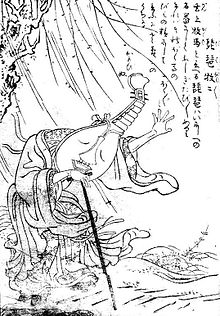Biwa-bokuboku

TheBiwa-bokuboku(Japanese:Tỳ bà mục 々;meaning "Biwa goblin" ) is afictitiousbeing fromJapanesefolklore.It belongs to a group ofyokaiand is said to have an ambivalent character.
Description[edit]
The Biwa-bokuboku is described as ananthropomorphicbeing with the head of atraditionalbiwa.He is also said to wear preciouskimono.The Biwa-bokuboku comes to life at night and sits calmly in atatamiroom, singing and plinking while lamenting the neglect of his former owner. Other stories report of Biwa-bokuboku dancing through inhabited houses while making much noise.[1][2][3]
Background[edit]
The Biwa-bokuboku was modeled after thebiwa(Tỳ bà), a short-necked, woodenlute.Toriyama Sekienreports in his workHyakki Tsurezure Bukuro(Trăm khí uổng phí túi) that the biwa was designed afterChineseinstruments such as thebokumaand thegenjō.[1][2][3]
The Biwa-bokuboku belongs to a special group of yōkai: theTsukumogami(Japanese:Phó Tang Thần,lit. 'artifact ghosts'). This special group is believed to comprise nearly all kinds of man-made household artifacts, such as kitchenware, tools and every-day accessories, when 100 years have passed and the artifact was as good as if it had never been used.[4]The Biwa-bokuboku will come to life when feeling ignored or useless. As revenge (and out of frustration), they wander through the rooms of inhabited houses at night and lament loudly over their neglect. Alternatively, they meet with other Tsukumogami and throw noisy parties or they leave home and stroll around in search of others with whom to commiserate.[1][2][3]
References[edit]
- ^abcdSekien Toriyama, Mamoru Takada, Atsunobu Inada u.a.: Họa đồ bách quỷ dạ hành, Kokusho Kankōkai, Tōkyō 1992,ISBN9784336033864,p. 295.
- ^abcKatsumi Tada: Ảo tưởng thế giới の trụ người たち. 4, Nhật Bản biên. Shinkigensha, Tokyo 1990,ISBN978-4-915146-44-2,p. 303.
- ^abcMasaharu Takemura: ろくろ đầu khảo: Yêu quái の sinh vật học. Bungei-sha, Tokyo 2002,ISBN4835546350,p. 89-91.
- ^Michaela Haustein:Mythologien der Welt: Japan, Ainu, Korea.ePubli, Berlin 2011,ISBN3844214070,S. 53.
